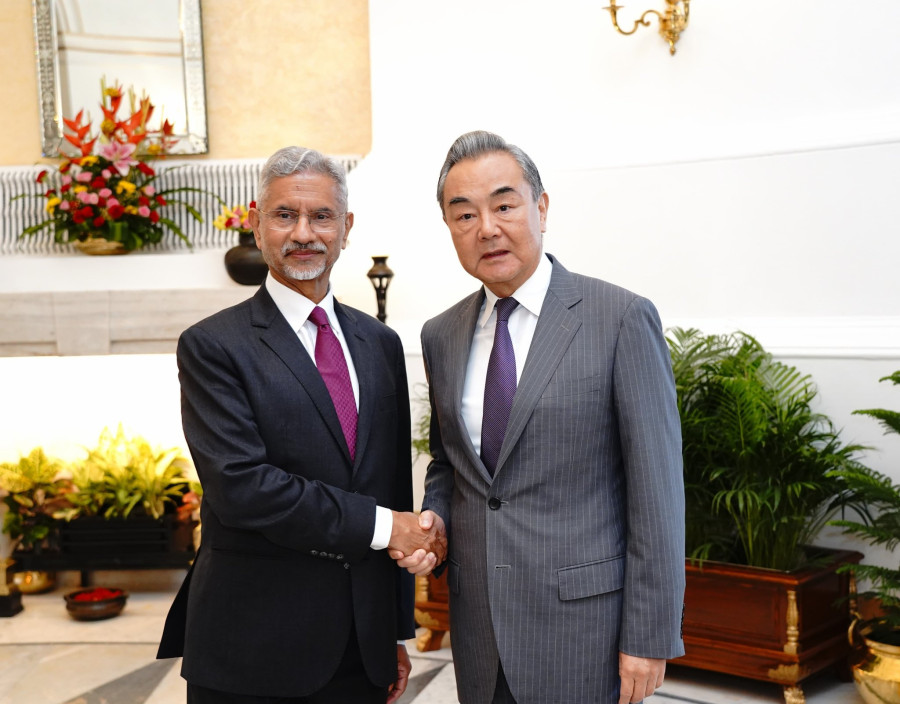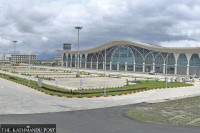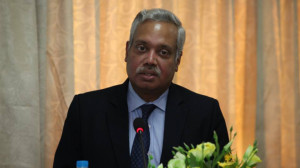National
New India-China deal on Lipulekh reopens old wound for Nepal
Agreement comes just ahead of PM Oli’s visit to the two countries. Experts call it a challenge to Nepal’s sovereignty.
Anil Giri
Ahead of the India and China visit of Prime Minister KP Sharma Oli, a tri-junction at the far end of Nepali territory—Lipulekh pass, which touches both India and China—has become the centre of a new controversy.
Prime Minister Oli is set to visit Tianjin, China at the end of this month to attend the Shanghai Cooperation Organisation (SCO) summit, followed by an official visit to India on September 16.
With this renewed agreement between India and China, pressure is now mounting on Oli to take up the matter with the two countries’ leadership.
During the 24th round of the Special Representatives’ dialogue on the boundary between India and China in New Delhi on Tuesday, India’s National Security Advisor Ajit Doval and China’s Foreign Minister Wang Yi agreed to reopen the three traditional border trading routes, including one that runs via Lipulekh pass.
Both sides agreed to reopen border trade through the three designated trading points, namely Lipulekh pass, Shipki La pass and Nathu La pass, India’s Ministry of External Affairs said in a statement. On the other hand, the Chinese Ministry of Foreign Affairs also mentioned the same agreement in its statement.
“Agreed to re-open the three traditional border trading markets, namely Renqinggang-Changgu, Pulan-Gunji and Jiuba-Namgya,” said the statement issued by China's Ministry of Foreign Affairs.
The Lipulekh Pass is known as Pulang-Gunji in local Tibetan dialect. Gunji is one of three villages located in the Kalapani area. Though currently under Indian control, Nepal has consistently asserted its claim over the area.
Reacting on the latest development of Lipulekh Pass, the Ministry of Foreign Affairs reaffirmed that the official map of Nepal, as incorporated in the Constitution of Nepal, includes Limpiyadhura, Lipulekh, and Kalapani—located east of the Mahakali River—as integral parts of Nepali territory.
“It is well known that the government of Nepal has consistently urged the government of India not to carry out any activities such as road construction/expansion or border trade in that area. The fact that the area is Nepali territory has also been communicated to the friendly nation, China,” said the statement.
In accordance with the spirit and sentiment of the close and friendly relations between Nepal and India, the government of Nepal remains committed to resolving the boundary issue between the two countries through diplomatic means, based on historical treaties and agreements, facts, maps, and evidence, said the statement.
Earlier in May, 2020, when India’s Defense Minister Rajnath Singh inaugurated a ‘link road’ to Lipulekh, the Ministry of Foreign Affairs had expressed “regret” and stated that as per the Sugauli Treaty of 1816, all the territories to the east of the Kali (Mahakali) River, including Limpiyadhura, Kalapani and Lipulekh, belong to Nepal.
“This was reiterated by the government of Nepal several times in the past and most recently through a diplomatic note addressed to the government of India dated 20 November 2019 in response to the new political map issued by the latter,” the foreign ministry had said in a statement on May 9, 2020.
It may be recalled that back in 2015 the government of Nepal had expressed its disagreement through separate diplomatic notes addressed to India and China when the two sides agreed to include Lipulekh pass as a bilateral trade route without Nepal’s consent during the official visit of the Prime Minister of India to China, the foreign ministry said in a statement in May, 2020.
Bishnu Pukar Shrestha, Nepal’s ambassador to China for over two years until 2024-end, said the prime minister should take up the matter with Chinese leaders. “The prime minister should tell them clearly that they should respect the sensitivity of the tri-junction.”
“If they take such a decision unilaterally, it will be seen as an attack on Nepal’s sovereignty. They should consult Nepal before taking any such decisions,” said Shrestha.
But according to historical archives and records, India and China have been bypassing Nepal on Lipulekh Pass since 1954, when they agreed trade through the pass with Tibet and India. On April 29, 1954, in an agreement between India and China, both sides agreed to allow pilgrims and traders to travel via Shipki La pass; Mana pass; Niti pass; Kungri Bingri pass; Darma pass and Lipulekh pass.
“Lipulekh pass offers one of the shortest routes between India and China for trading, people to people contact and pilgrimage, so both nations keep updating past agreements without informing us,” said a former Nepali diplomat who served in New Delhi. (In order to increase its engagement in the area, India has been building a link road up to Lipulekh pass.)
Again on December 13, 1991 India and China signed a memorandum of resumption of border trade and agreed to establish border trade market from Pulang in Gunji.
“With the view of facilitating the visits of persons engaged in border trade and exchange of commodities and means of transportation, [India and China] have decided that Lipulekh (Qiangla) be the border pass for the entrance and exit of the said persons, commodities and means of transportation of the two sides,” said the agreement reached in 1991.
Then, on 1 July, 1992, India and China signed a protocol on “entry and exit procedures for border trade” where they agreed that “Lipulekh (Qingla) pass shall be the border pass for entry and exit of persons, commodities and means of transport engaged in border trade, exchange of commodities, and means of transportation.”
“The parties shall designate market sites at Gunji (India) and Pulan (China), respectively for the border trade,” the protocol read.
Similarly, in 2005, during Chinese Premier Wen Jiabao’s India visit, the two countries signed a protocol on modalities for the implementation of confidence-building measures along the line of actual control in the India-China border areas. They agreed in principle to expand the mechanism of border meeting points to include Kibithu-Damai in the Eastern Sector and Lipulekh pass/Qiang La in the Middle Sector. The precise locations of these border meeting points was to be decided through mutual consultations, read the India-China statement issued on April 11, 2005.
When this agreement was made public, Nepal’s Ministry of Foreign Affairs had raised the issue with both the Indian and Chinese embassies in Kathmandu and registered its strong displeasure.
Again, in 2014, during the state visit of Chinese President Xi Jinping to India, the two countries signed a memorandum of understanding on opening a new route for Kailash Mansarovar pilgrimage in Tibet.
“The MoU provides for conducting the annual Kailash Manasarovar Yatra through Nathu La pass in Sikkim in addition to the existing Lipulekh pass in Uttarakhand. The route through Nathu La will augment the capacity and reduce the hardship and journey time enabling many more pilgrims, in particular aged pilgrims to undertake the Yatra,” read the statement issued on September 18, 2014.
But the spate of agreements on Lipulekh pass between India and China did not end here. During the official visit of Chinese Prime Minister Narendra Modi to China in May 2015, the two countries renewed an agreement on trade and pilgrimage by the people of the two counties.
“The two sides recognized that enhancing border areas cooperation through border trade, pilgrimage by people of the two countries and other exchanges can effectively promote mutual trust, and agreed to further broaden this cooperation so as to transform the border into a bridge of cooperation and exchanges. The two sides agreed to hold negotiations on augmenting the list of traded commodities, and expand border trade at Nathu La, Qiangla/Lipulekh pass and Shipki La,” said point number 28 of the joint statement between India and China.
The then government led by Prime Minister Sushil Koirala objected to the joint agreement, Dinesh Bhattarai, who was the foreign relations advisor to Koirala in 2015, recalls.
Nepal has been occasionally raising the issue with India and China. But experts and diplomats said time has come to raise it more vocally with both the countries.
On Wednesday evening, former prime minister Baburam Bhattarai took to X to criticise the deal. “India and China reaching an agreement to resume trade through the Lipulekh pass without consulting Nepal is a matter of serious concern for Nepal’s national interest,” he wrote.
“This territory, which Nepal has long claimed, which India has also acknowledged as a matter of dispute, and which China has said it would decide only after consulting Nepal—having these two large neighbors unilaterally agree again—is a major challenge to Nepal’s sovereignty, independence, and territorial integrity,” writes Bhattarai.
The government of Nepal should take diplomatic and political steps seriously to defend the national interest, he added.
Bipin Adhikari, a constitutional expert who often writes on geopolitics, says India and China cannot decide on this route bilaterally without Nepal’s consent. “Doing so violates international law and reflects hegemony. PM Sushil Koirala’s government raised this concern long ago, yet our neighbours remain unneighborly,” he said.




 9.12°C Kathmandu
9.12°C Kathmandu















